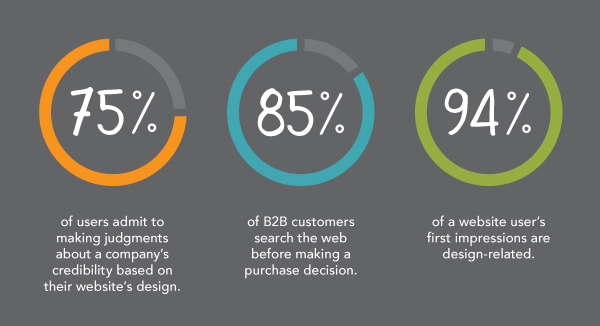

There are many, many posts about websites and website design. The types of pages you need, blogs, landing pages. They often miss the big picture elements you need to be aware of.
This post will separate the wheat from the chaff and show you exactly what your website needs to add serious value to your business.
"94% of people cited web design as the reason they mistrusted or rejected a website."
- Ironpaper
Key takeaways:
"Web design is not just about creating pretty layouts. It's about understanding the marketing challenge behind your business."
- Mohamed Saad
There's a myth that websites only need to cost a $1000 or £500. "My cousin designs websites and he said he'd do it for free". I'm sure your cousin designs great websites, but if they really were that good, they
Have you ever heard of a great lawyer or accountant being so good they don't charge anything? They're both skills that anyone can learn, but you get what you pay for. You wouldn't say "my mate can do it for £20" to a mechanic and expect the same results.
Remember, just because something pretty can easily or cheaply be created, it does not mean that it is "correct" or effective. A successful website (in terms of generating business) is not because it's great looking. That may be a part of it, but there's a lot more going on to make a website successful. And that's what you're paying for.
Your website is no longer "a little place on the internet that's yours". If it's a genuine addition to your business, then it should be providing a measurable impact on your business. It should be helping you get leads, sales and better customer relationships.
Just having a website as an online brochure isn't enough for your business. You need to produce relevant and up-to-date content for your customers. That really is all you should be focusing on. Helping your customers, and being useful and valuable to them.
If your customers find you useful, then non-customers will too.
You're having to compete with so much more now. The level of noise on the internet is insane these days. So you need to stand out, and what helps you to stand out over your competitors and over other distractions (Facebook, Netflix, Imgur) is providing superb, useful content that people want to read. It's that simple.
"Great web design without functionality is like a sports car with no engine."
- Paul Cookson
And the icing on the cake? You need to collect email addresses and leads and market to them effectively. Your website can only do so much. But what it can do is SERIOUSLY top up your sales pipeline with fresh, hungry leads.

The easiest problem to fix with a website (and something that everyone will experience at some point), is a website that just simply is not working.
It might load slowly because the hosting is poor, or images are poorly optimised. If you're not paying enough for your hosting, the website could take ages to load. And anything over 2 seconds is often enough to bore a potential customer enough to have them look elsewhere.
Another issue that websites face is 'broken code'. This is a massive topic in its own right. But typically, website updates, core code updates and platform changes can break a site, even if everything was working beforehand. Conversely, not having these updates occur can also break a site. Sites not regularly updated can be open season to hackers as many updates close regularly uncovered security holes. So you need your website to be managed and maintained regularly and safely.
If you don't pay for a proper, well maintained and updated site, your website WILL break.
It happens all the time and it literally is super easy to prevent. But much harder (and retrospectively more costly) to fix. I know my preference...
"Content precedes design. Design in the absence of content is not design, it's decoration."
- Jeffrey Zeldman
You would not believe the amount of business websites, designed to sell a service to other businesses, feel it necessary to talk about their Owner's love of fishing, or rock climbing, or their cat .
At a more relatable level, we see many businesses write about and publish content that's plain, and simply not aimed at their customers. If you're an architect, talk about stuff that helps your customers. Talk about energy efficiency in homes. Talk about how sustainable building materials.
There's a huge misconception that if you work in a particular industry, you can only ever talk about that industry and those products. The truth is that you should be talking about and around your customers; helping them. Talk about what they want to hear, not what you want to say.
Don't - as we see many businesses do - talk about things that would appeal to other people in your industry. That is, avoid writing content that would be better suited to your competitors
Finally, and this is the most common issue we see, you need to create content and update your site REGULARLY. We often see people publishing and launching a website and months later the blog section is still empty.
We know it sounds hard to create content every week, but it isn't. If you're struggling to think of things to say or talk about, we can help you. If you genuinely don't think you have anything to say, then what exactly are you selling?
Talk about what your customers want to hear. I promise that you've got more content than you realise on your business and products. Let us help you find it and get it to work for your business, generating new leads and customers.
"Given 15 minutes to consume content, two-thirds of people would rather read something beautifully designed than something plain"
- Adobe
As a starter, you need to commit to producing one new piece of content every week. It's as simple as that. If you have a plan, it's really not as daunting as you think.
The easiest way to get started is to think of 5 broad topics that your customers want to hear about and that you want to talk about.
If you're a dog groomer, what are the 5 basic topics that come up between you and a customer? For example,
What are the most common questions that you get about those topics? When customers email you, what do they ask you? What are you constantly having to tell people when you first meet them?
You could do each question as a post or have a commonly asked questions post.
Think about topics that customers should know. Things that they discover as they use you more and get to know your products. Talk about the results that they can get or success stories you've had.
Make sure you're talking about your business and what makes you different. Who are the people in your business and what's their take on the broad subjects?
Even if you just took these 3 questions for each broad topic, that's 15 pieces of content.
Once someone has read your post, we want them to sign up and provide you with their email address and contact info so you can market to them. You get this by offering another useful, highly valuable piece of content in exchange for an email address
Ask them "if you liked this piece about [topic], then you'll love our guide to [topic]". Focus on the benefit they get by giving you their email address and showing them what they can do after they sign up.
Think about what the next logical step would be for someone reading that blog post. For example if I'm reading a post about buying a new washing machine, the next logical step would be a guide on the 5 best washing machines of 20-whatever-the-current-year-is.
Keep your next step related to the original content. Make it a next step or an added bonus. What would someone truly want to see next if they were reading your content?
We love the idea of asking “if you liked that, you'll love this” as a next step. We use it on our sign up forms and landing pages all the time. A lot of customers ask us “well, why should we pay more if so-and-so down the road can do it for $500?” Our response is that we understand what they're saying but tell them that ultimately you generally do get what you pay for.
Our customers
If you liked our blog post on website design (see what we're doing?) then you'll love our guide on some quick actionable fixes you can make on your site to improve your business.